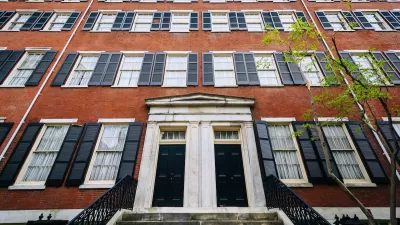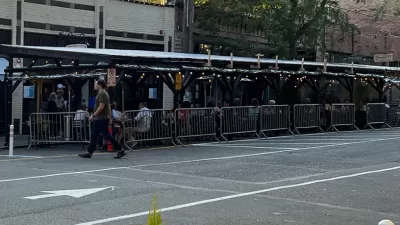A strongly worded opinion piece calls out historic preservation as a tool of the affluent urban elite.

Binyamin Appelbaum, a member of the editorial board of the New York Times, writes a criticism of historic preservation in the wake of a controversy about solar panels on historic homes in the historic district of Capitol Hill in Washington, D.C, where Appelbaum lives.
Here's how Appelbaum summarizes the conflict:
Humans don’t like change, so it’s not surprising that historic preservation laws have become quite popular. There are now more than 2,300 local historic districts across the United States, and I know many people who would like to have their own neighborhood frozen in time.
But historic preservation comes at a cost: It obstructs change for the better. And while that price is generally invisible, it is now on public display because of the city’s efforts to prevent Washington homeowners in historic neighborhoods from installing visible rooftop solar panels.
Appelbaum describes some of the very strict rules the Capitol Hill historic district has for alterations to homes in the area, and with some of these restrictions it shouldn't be hard to imagine that solar panels aren't welcome, even in the midst of climate change. An October controversy over a D.C. homeowner's petition to add solar panels created an uproar, leading to some changes that will make it easier to "a little easier to win permission to put solar panels on historic homes," according to Appelbaum, but "the fact that Washington continues to impose any aesthetic restrictions on rooftop solar panels is still a problem — and it is emblematic of the broader problems with preservation."
That problem, according to Appelbaum, has less to do with preserving history, and more to do with preserving "the lifestyle of an affluent urban elite."
FULL STORY: When Historic Preservation Hurts Cities

Alabama: Trump Terminates Settlements for Black Communities Harmed By Raw Sewage
Trump deemed the landmark civil rights agreement “illegal DEI and environmental justice policy.”

Planetizen Federal Action Tracker
A weekly monitor of how Trump’s orders and actions are impacting planners and planning in America.

Why Should We Subsidize Public Transportation?
Many public transit agencies face financial stress due to rising costs, declining fare revenue, and declining subsidies. Transit advocates must provide a strong business case for increasing public transit funding.

Understanding Road Diets
An explainer from Momentum highlights the advantages of reducing vehicle lanes in favor of more bike, transit, and pedestrian infrastructure.

New California Law Regulates Warehouse Pollution
A new law tightens building and emissions regulations for large distribution warehouses to mitigate air pollution and traffic in surrounding communities.

Phoenix Announces Opening Date for Light Rail Extension
The South Central extension will connect South Phoenix to downtown and other major hubs starting on June 7.
Urban Design for Planners 1: Software Tools
This six-course series explores essential urban design concepts using open source software and equips planners with the tools they need to participate fully in the urban design process.
Planning for Universal Design
Learn the tools for implementing Universal Design in planning regulations.
Caltrans
Smith Gee Studio
Institute for Housing and Urban Development Studies (IHS)
City of Grandview
Harvard GSD Executive Education
Toledo-Lucas County Plan Commissions
Salt Lake City
NYU Wagner Graduate School of Public Service





























